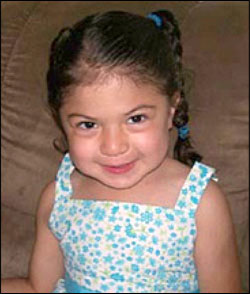
Am Fam Physician. 2008;78(4):456
The long journey began in May 2004 when I first believed I was pregnant. Like any other expectant mother, I experienced joy, confusion, and questions. Who better to turn to than your doctor? In the first few months, I was diagnosed with gestational diabetes. It was a surprise, but my doctor was always very patient; she had a plan, recommendations, and goals in mind. I was continuously monitored and had many tests performed. Everything was coming back normal when, one day in October, a sharp pain woke me up, followed by many more. I gathered my bags and headed to the hospital.

E.M.J. was born by C-section at 5:03 p.m. I heard her first cry, but as I turned my head toward the incubator, I clearly saw her undergoing CPR. Minutes later, she was transported to the NICU in serious condition. I felt helpless. As I laid in recovery, many doctors and specialists, including my own doctor, kept me informed about my baby girl. The first few hours were critical, and her chance for survival was slim.
I was not able to visit my daughter until the next morning. The first person who came knocking at the door was my doctor with the news that E.M.J. had made it through the most critical stage. She said she was very hopeful, gave me a hug, and reiterated her support. I remember crying and saying, “I would have never expected this.” I kept blaming myself for everything and prayed to God to keep my daughter alive. My doctor was there every day; her courage, strength, and support helped me keep my head up high.
My daughter suffered severe meconium aspiration, and had three brain hemorrhages, an enlarged kidney and liver, and bilateral clubfeet. The journey continued well after her 23-day stay in the NICU. Outpatient appointments were scheduled for multiple tests and screenings. Now, I believe that God doesn't give us anything we can't handle. E.M.J. was a true miracle, and I want to thank our doctor for providing her shoulder to cry on.—d.g.
COMMENTARY
E.M.J. struggled with bilateral clubfeet the first one and a half years of her life, and as a result was behind on her vaccines, walking, and early gross motor skills. There was also an early risk of seizure neonatally because of intra-ventricular hemorrhage. E.M.J. is now a highly verbal, fun loving, and active three-year-old who has “caught up” for her age. Her challenging start in life is really undetectable.
D.G.'s story illustrates two important roles that family physicians can play in caring for their patients. First, family physicians are integral in the coordination of their patient's medical care. When E.M.J.'s condition deteriorated, and she became high risk, was emergently delivered, and remained in the neonatal intensive care unit for three weeks, most of her day-to-day medical care remained in the hands of the specialists. My understanding of D.G.'s medical and social history, and my preexisting relationship with her family allowed me to advocate for E.M.J. and her parents, and to help interpret and coordinate the specialists' care.
Second, there is value in the family physician providing continuous maternity and newborn care as part of a full-spectrum practice. Providing preconceptive counseling, antenatal, natal, postnatal, and infant and pediatric care gives me tremendous satisfaction. Many families return for subsequent births and bring in their immediate and extended family.